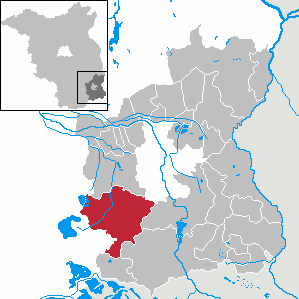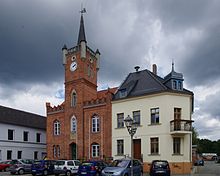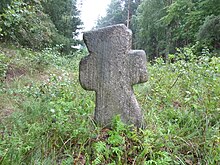Drebkau
| coat of arms | Germany map | |
|---|---|---|

|
Coordinates: 51 ° 39 ' N , 14 ° 13' E |
|
| Basic data | ||
| State : | Brandenburg | |
| County : | Spree-Neisse | |
| Height : | 87 m above sea level NHN | |
| Area : | 143.91 km 2 | |
| Residents: | 5509 (Dec. 31, 2019) | |
| Population density : | 38 inhabitants per km 2 | |
| Postal code : | 03116 | |
| Area code : | 035602 | |
| License plate : | SPN, FOR, GUB, SPB | |
| Community key : | 12 0 71 057 | |
| LOCODE : | DE BXD | |
| City structure: | 10 districts | |
City administration address : |
Spremberger Strasse 61 03116 Drebkau |
|
| Website : | ||
| Mayor : | Paul Koehne ( CDU ) | |
| Location of the city of Drebkau in the Spree-Neisse district | ||
The town of Drebkau [ ˈdrɛpka͜u ] (rarely also written Drepkau ), Drjowk in Lower Sorbian , is located southwest of Cottbus in the Spree-Neisse district in Brandenburg .
City structure
The city is divided into the following districts (Sorbian names in brackets) with the associated districts and residential areas:
- Casel ( Kózle ) with the municipality part Illmersdorf ( Njamorojce ) and the residential area Göritz ( Chórice )
- Domsdorf ( Domašojce ) with the municipality part Steinitz ( Šćeńc )
- Drebkau ( Drjowk ) with the municipality part Golschow ( Gólašow ) and the residential areas Golschower Buden ( Gólšojske budy ), Kaupmühle ( Kuparski młyn ) and Raakow ( Rakow ). The district of Drebkau also includes the former district and location of the devastated village of Kausche
- Greifenhain ( Maliń ) with the Radensdorf ( Radowašojce ) municipality and the Greifenhain colony residential area ( Kolonija Maliń )
- Jehserig ( Jazorki ) with the municipality parts Merkur ( Merkur ), Papproth ( Paprotna ) and Rehnsdorf ( Radušc )
- Thimble ( Chusej ) (New thimble)
- Laubst ( Lubošc ) with the community town of deleting ( Lĕźiny ) and the living quarters Laubster expansion ( Lubošcańske wutwarki ) and Löschener booths ( Lěźinske Budki )
- Leuthen ( Lutol ) with the Kolonie Winkel ( Kolonijowy nugłyšk ) residential area . The former municipality of Wintdorf was completely absorbed in Leuthen .
- Schorbus ( Skjarbošc ) with the municipality parts Auras ( Huraz ) and Klein Oßnig ( Wóseńck ) as well as the residential areas Alte Ziegelei ( Stara cyglownja ), Reinpusch ( Rampuś ), Oelsnig ( Wólšynka ) and Schorbus extension ( Skjarbošcańske wutwarki )
- Siewisch ( Źiwize ) with the community part Koschendorf ( Kóšnojce ) and the residential area Bollmühle ( Bolojski młyn )
history
First mention
The first mention of Drebkau was conventionally but incorrectly assumed for the year 1280. This was based on a mention in a Welzow document together with Steinitz. As in Welzow, reference was made so far to a copy of a parchment that is no longer legible and on which the year 1280 was read. After intensive research in the state archives of Potsdam and Dresden , Joachim Schneider (Welzow / Dresden) was able to prove in May 2005 that the oldest surviving mention of Drebkau dates back to 1353. The original documents are in the state archives of Brandenburg and Saxony. Nevertheless, the 725th anniversary of the city of Drebkau took place in 2005.
Attack on the railroad in 1903
On May 29, 1903, the passenger train No. 983 derailed at Drebkau station on the Grossenhain – Cottbus line after a drunken carpenter had laid a sleeper across the track. The locomotive and three following cars derailed, with the car directly following the locomotive being completely smashed. One dead, three seriously and five slightly injured were the result.
Administrative history
Drebkau and its current districts of Casel, Domsdorf, Greifenhain, Kausche, Laubst and Siewisch have belonged to the Calau district since 1816 , Leuthen and Schorbus to the Cottbus district and Jehserig to the Spremberg district (all in the Prussian province of Brandenburg ). In 1952 they were incorporated into the Cottbus-Land district (Kausche in the Spremberg district ) in the GDR district of Cottbus . Since 1993 the places have been in the Brandenburg district of Spree-Neisse.
On July 1, 1950, the previously independent community Raakow was incorporated. The former municipality of Kausche was reclassified to Drebkau on September 29, 1996. On December 31, 2001, the following eight communities were incorporated into Drebkau: Casel, Domsdorf, Greifenhain, Jehserig, Laubst, Leuthen, Schorbus and Siewisch. The Drebkau (Niederlausitz) office that existed until then was dissolved. Drebkau became an office-free city.
Population development
|
|
|
|
|
Territory of the respective year, number of inhabitants: as of December 31 (from 1991), from 2011 based on the 2011 census
politics
City Council
Drebkau's city council consists of 18 city councilors and the full-time mayor.
| Party / group of voters | Seats |
|---|---|
| CDU | 6th |
| The left | 3 |
| AfD | 3 |
| SPD | 2 |
| Together for Drebkau - BVB / Free Voters | 2 |
| Districts Bündnis Stadt Drebkau | 2 |
(As of: local election on May 26, 2019)
mayor
- 1998–2002: Sabine Schneider
- 2002–2010: Harald Altekrüger (CDU)
- 2010–2018: Dietmar Horke (independent)
- from 2018: Paul Köhne (CDU)
Köhne was elected in the mayoral election on May 6, 2018 with 63.5% of the valid votes for a term of eight years.
coat of arms
The coat of arms was approved on May 2, 2003.
Blazon : “In blue a continuous silver battlement wall with two tinned, black-windowed, red-roofed and kneaded silver towers and a pointed arched gate with a raised red portcullis; between the towers a floating red shield covered with a double-tailed, gold-armored, tongued and crowned silver lion. "
Town twinning
Drebkau has a partnership relationship with Czerwieńsk in Poland .
Sights and culture
Attractions
See also: List of architectural monuments in Drebkau and List of ground monuments in Drebkau
There are two castles in Drebkau : Drebkau Castle and Raakow Castle . Another building worth seeing is the town hall. The manor house in Koschendorf, which is also listed, is unfortunately falling into disrepair.
A stone cross made of gray granite is located east of the Greifenhain district. It stands north of the road to Radensdorf west of the Greifenhainer river. It used to be used as a walkway over this tile, which is why the front is smooth.
The Steinitz staircase is a lookout point built in 2012 about 3.5 km south of Drebkau near the Steinitz district. The sloping metal construction resembles the shape of a conveyor bridge and leads to a 19 m high viewing platform , from which there is a very good view of the Welzow-Süd opencast mine and the Oberlausitzer Bergland . An inclined elevator is installed along the railing to allow access for people with disabilities.
The Illmersdorf mummies can be viewed in the Illmersdorf district.
Regular events
On Ash Monday, every year is the the Drebkauer Carneval Club hosted traditional Rose Monday parade followed by a party held in the town square.
The Drebkau Nikolausmarkt, which is primarily aimed at children, has been held for several years by the “Initiative Drebkau eV” association, other associations and the Drebkau local council.
The Drebkau roundabout has been held annually since 2005 , a cycle tour through the municipality.
A centuries-old Sorbian custom, St. John's riding , is maintained in the Casel district .
The annual “Drebkau Dragon Festival” and the “Drebkau Mushroom Hike” held every 2nd weekend in October have met with a great response.
Economy and Infrastructure
Established businesses
The companies Ardagh Glass Germany GmbH , a manufacturer of container glass , Landhandel Drebkau GmbH, Agrargenossenschaft Drebkau eG and Agrar GmbH Schorbus are located in the city.
traffic
Drebkau is located on federal highway 169 between Senftenberg and Cottbus and on state road L 52 between Calau and Spremberg . The nearest motorway junction is Cottbus-West on the A 15 ( Spreewald- Polish border triangle ), about 10 km to the northeast.
Drebkau station is on the Großenhain – Cottbus line and is served by the RE 18 Cottbus - Dresden regional express line and the RB 49 Falkenberg (Elster) - Cottbus regional train line. The RB 49 line also serves the Leuthen stop .
education
The Drebkau primary school is located in Drebkau . The Drebkau Oberschule has been closed since July 2007. Another primary school is in Leuthen.
societies
The city has several clubs, such as the Drebkau City Fire Brigade Association , the Drebkauer Carneval Club , the Steinitzer Alpenverein , the Kauscher Carnival Club and the 1st Drebkau Fishing Club .
Sports
In Drebkau there is the SV unit Drebkau , which offers the sports football, billiards, bowling and gymnastics. Further football clubs are the SG Kausche , SV Leuthen / Oßnig and the SG Blau-Weiß Schorbus .
Personalities
- Otto Krosta (1844–1925), general practitioner in Drebkau from 1868 to 1878
- Ernst von Werdeck (1849–1905), manor owner and member of the Reichstag
- Ewald Müller (1862–1932), teacher, local poet and local researcher
- Gotthelf Matthias Bronisch (1868–1937), Protestant pastor and linguist, born in Leuthen
- Bogumił Šwjela (Gotthold Schwela) (1873–1948), Sorbian Protestant clergyman, born in Schorbus
- Georg Dix (1897–1967), resistance fighter and politician
- Max Biala (1905–1942), SS-Unterscharführer in the Treblinka extermination camp, born in Lassen
- Matthias Körner (* 1954), writer, lives and works in Illmersdorf
- Harald Altekrüger (* 1955), politician (CDU), district administrator of the Spree-Neisse district , 2003–2010 mayor of Drebkau
- Ralf Daubitz (* 1961), soccer player, born in Schorbus
- Julian Brüning (* 1994), politician (CDU), member of the state parliament, grew up in Drebkau
Web links
- City of Drebkau
- Material on Drebkau Castle (PDF; 250 kB) in the Duncker Collection of the Central and State Library Berlin
- Schorbus in the RBB program Landschleicher on May 3, 2009
- Greifenhain in the RBB program Landschleicher on August 31, 2014
Individual evidence
- ↑ Population in the State of Brandenburg according to municipalities, offices and municipalities not subject to official registration on December 31, 2019 (XLSX file; 223 KB) (updated official population figures) ( help on this ).
- ^ City of Drebkau . Service portal of the state administration of the state of Brandenburg
- ^ Ludwig Ritter von Stockert : Railway accidents. A contribution to railway operations theory. , Vol. 1. Leipzig 1913, p. 270, no.198.
- ^ StBA: Changes in the municipalities in Germany, see 1996
- ↑ StBA: Changes in the municipalities in Germany, see 2001
- ↑ Historical municipality register of the state of Brandenburg 1875 to 2005. District Spree-Neisse . Pp. 14-17
- ↑ Population in the state of Brandenburg from 1991 to 2017 according to independent cities, districts and municipalities , Table 7
- ^ Office for Statistics Berlin-Brandenburg (Ed.): Statistical report AI 7, A II 3, A III 3. Population development and population status in the state of Brandenburg (respective editions of the month of December)
- ^ Result of the local election on May 26, 2019
- ↑ Results of the municipal elections in 1998 (mayoral elections) for the Spree-Neisse district ( memento of the original from April 17, 2018 in the Internet Archive ) Info: The archive link was inserted automatically and has not yet been checked. Please check the original and archive link according to the instructions and then remove this notice.
- ↑ Local elections October 26, 2003. Mayoral elections , p. 32
- ↑ Dietmar Horke elected the new mayor of Drebkau. In: Lausitzer Rundschau , September 13, 2010
- ↑ Brandenburg Local Election Act, Section 74
- ^ Result of the mayoral election on May 6, 2018
- ↑ Coat of arms information on the service portal of the state administration of Brandenburg
- ↑ Dietrich Neuber, Günter Wetzel: Stone crosses cross stones inventory district Cottbus . Cottbus. 1982
- ↑ Lookout point “Steinitz Staircase” opened next to opencast mine . In: Lausitzer Rundschau , August 2, 2012; Retrieved April 6, 2015
- ↑ Flyer for an exhibition "John the Baptist - Christian Roots and Customs in South Brandenburg" (summer 2008)








